Electron Devices and Circuits: Unit II: (b) Junction Field Effect Transistor (JEET)
Characteristics of JFET
Drain and Transfer Characteristics
The important characteristics of JFET are drain characteristics and transfer characteristics. The following section explains these characteristics in detail.
Characteristics of JEET
AU
: May-12, 13, 14, 17, Dec.-O2, 08, 10
•
To understand electrical behaviour of a JFET, it is necessary to study the
interrelation of the current and voltages in JFET. These relationships can be
plotted graphically which are commonly known as the characteristics of JFET.
The important characteristics of JFET are drain characteristics and transfer
characteristics. The following section explains these characteristics in
detail.
1. Drain Characteristics
•
Fig. 3.4.1 shows the drain characteristics of a n-channel JFET. The curves
represent relationship between the drain current ID and drain to source voltage
VDS for different values of VGS. Fig. 3.4.2 shows the experimental
setup required to plot this characteristics.
•
Vcs and VDS both = 0 : When VGS = 0 the channel is entirely open.
But VDS = 0, so there is no attractive force for the majority carriers
(electrons in n-channel JFET) and hence drain current does not flow.
•
Self pinch-off at no bias (VGS = 0) : At VGS = 0, in
response to a small applied voltage VDS, the n-type bar acts as a simple
semiconductor resistor, and the current ID increases linearly with VDS. As VDS
increases, the voltage drop along the channel also increases. This increase in
voltage drop increases the reverse bias on gate-source junction and causes the
depletion regions to penetrate into the channel, reducing channel width. The
effect of reduction in channel width provides more opposition to increase in
drain current ID. Thus, rate of increase in ID with respect to VDS is now
reduced. This is shown by the curved shape in the characteristics.
•
At some value of VDS, drain current ID cannot be increased further, due to
reduction in channel width. Any further increase in VDS does not increase the
drain current ID ID approaches the constant saturation value. The voltage VDS
at which the current ID reaches to its constant saturation level is called
'Pinch-Off Voltage', Vp.
•
VGS with negative bias : When an external bias, of say -1 V, is
applied between the gate and the source, the gate channel junctions are further
reverse biased, reducing the effective width of the channel available for the
conduction. Because of this, drain current will reduce and pinch off voltage is
reached at a lower drain current than when VGS = 0, as shown in Fig. 3.4.1.
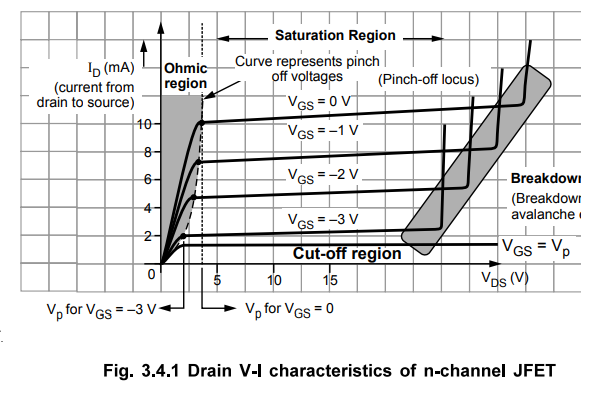
•
By applying several values of negative external bias voltage (VGS), a family of
curves are obtained as shown in Fig. 3.4.1. From Fig. 3.4.1 it can be observed
that for more negative values of VGS, the pinch-off voltage is reached at
lesser values of ID.
•
Breakdown region : We can observe from the Fig. 3.4.1 that if we
increase value of VDS beyond pinch-off voltage, Vp, the drain current ID
remains constant, up to certain value of VDS. If we further exceed VDS, the
voltage will be reached at which the gate-channel
junction breaks down, due to avalanche effect. At this point the drain current
increases very rapidly, and the device may be destroyed.
•
It can be observed that the values of VDS for breakdown are reduced as the
negative gate bias is increased. This is because the total reverse breakdown
voltage is the addition of the reverse voltage due to self pinch-off and the
externally applied voltage VGS
•
Ohmic and saturation regions :
•
It is seen that the drain characteristics of JFET is divided into two regions :
Ohmic region and saturation region. In the ohmic region, the drain current ID
varies with VDS and the JFET is said to behave as voltage variable resistance.
•
In the saturation region, the drain current ID remains fairly constant and does
not vary with VGS
•
Cut-off : As we know, for an n-channel JFET, the more negative VGS
causes drain current to reduce and pinch-off voltage to reach at a lower drain
current. When VGS is made sufficiently negative, ID is reduced to 0, as shown
in the Fig. 3.4.1. This is caused by the widening of the depletion region to a
point where it completely closes the channel. The value of VGS at the cut-off
point is designated as VGS (OFF)-
•
Relation of VGS (off) and Vp : ID is 0
when VGS = Drain characteristics for p-channel FET
•
In a p-channel JFET the source is positive with respect to the drain. Here the
source is the source of holes which flow through the channel to the drain. The
pinch-off is achieved by making the source to gate voltage, VgG negative (i.e.
VGS positive) there by reverse biasing the p-n junction diode formed by the
channel and the gate.
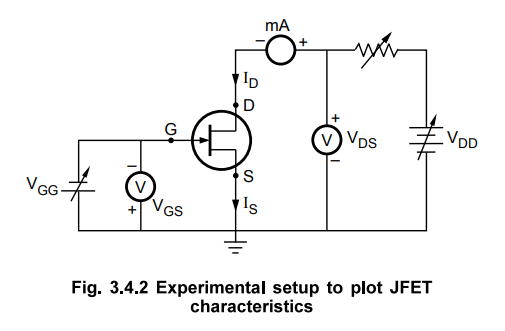
•
The Fig. 3.4.3 shows the drain characteristics of p-channel JFET. Note the
similarities between these characteristics and those shown for n-channel JFET
in Fig. 3.4.1.
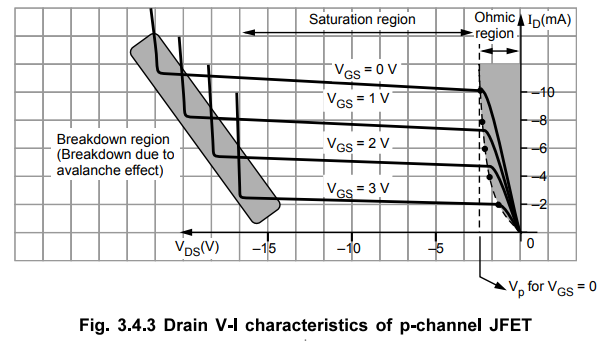
•
The curves are identical except that voltage VGS and VDS have reversed
polarities and current ID flows in reverse direction.
2. Transfer Characteristics
•
The relationship between the drain current ID and gate to source voltage VGS is
non-linear as shown in the Fig. 3.4.4. This relationship is defined by
Shockey’s equation
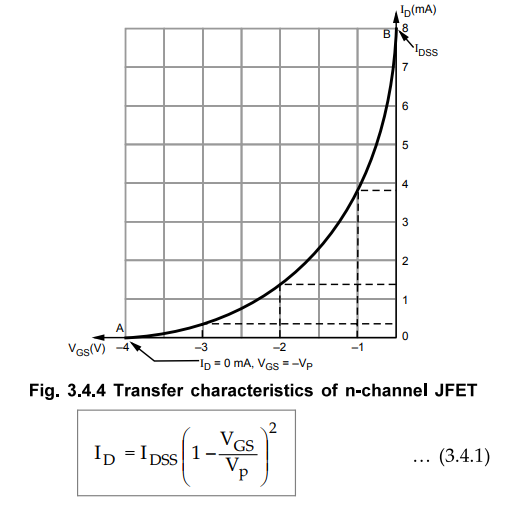
•
The squared term of the equation will result in a non-linear relationship
between ID and VGS producing a curve that grows exponentially with
decreasing magnitudes of VGS. From equation we can also write,
 •
In the equation values of IDSS and Vp are constants, value of VGS controls ID.
•
In the equation values of IDSS and Vp are constants, value of VGS controls ID.
•
A point A at the bottom end of the curve on the VGS-axis represents
VGS(off), and point B at the top end of the curve on the ID axis
represents IDSS (maximum drain current at VGS = 0). Thus, this curve
shows the operating limits of a JFET. These are :
•
ID = 0 when VGS = VGS(off)
•
ID = IDSS when VGS = 0
Transfer
characteristics for p-channel JFET
•
The Fig. 3.4.5 shows the transfer characteristics of p-channel JFET. It is
identical to transfer characteristics of n-channel JFET except that the
polarities of VGS and ID are reversed.
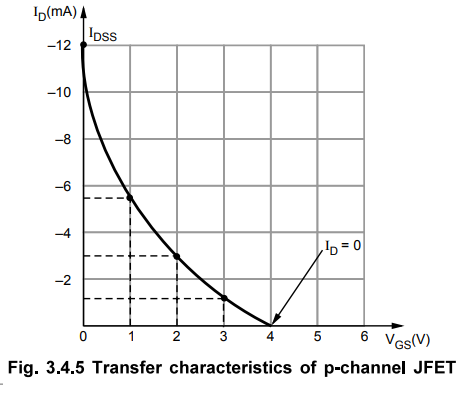
Review Questions
1. With relevant
diagrams and characteristic curves, explain the operation of JFET.
2. Draw the drain and
transfer characteristics of a n-channel JFET and explain.
3. Explain the
construction of N channel JFET. Also explain the drain and transfer
characteristics of the same.
AU : Dec.-10, Marks 16
4. Explain three
distinct regions of the output characteristics.
5. Define the
pinch-off voltage of JFET.
AU : May-13, Marks 2
6. Draw the drain
characteristics of FET and indicate important operating regions.
AU : May-14, Marks 2
7. Sketch and explain
the typical shape of drain characteristics of JFET for ^GS = 0 with indication
of four region clearly.
Electron Devices and Circuits: Unit II: (b) Junction Field Effect Transistor (JEET) : Tag: : Drain and Transfer Characteristics - Characteristics of JFET
Related Topics
Related Subjects
Electron Devices and Circuits
EC3301 3rd Semester EEE Dept | 2021 Regulation | 3rd Semester EEE Dept 2021 Regulation
